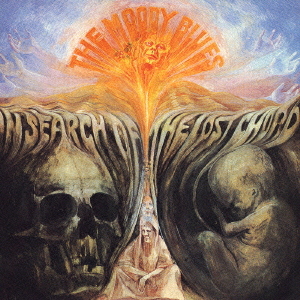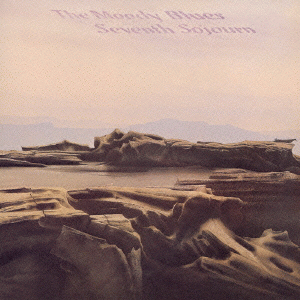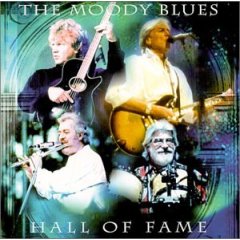
The Moody Blues were an English rock band formed in Birmingham in May 1964. The band initially consisted of drummer Graeme Edge, guitarist/vocalist Denny Laine, keyboardist/vocalist Mike Pinder, multi-instrumentalist/vocalist Ray Thomas, and bassist/vocalist Clint Warwick. Originally part of the British beat and R&B scene of the early–mid 1960s, the band came to prominence with the UK No. 1 and US Top 10 single "Go Now" in late 1964/early 1965. Laine and Warwick left the band by the end of 1966, being replaced by guitarist/vocalist Justin Hayward and bassist/vocalist John Lodge. They embraced the psychedelic rock movement of the late 1960s, with their second album, 1967's Days of Future Passed, being a fusion of rock with classical music that established the band as pioneers in the development of art rock and progressive rock. It has been described as a "landmark" and "one of the first successful concept albums".

Days of Future Passed is the second album and first concept album by English progressive rock band The Moody Blues, released in November 1967 by Deram Records.

A Night at Red Rocks with the Colorado Symphony Orchestra is a live album by The Moody Blues, recorded from a live performance at the Red Rocks Amphitheatre on 9 September 1992. This performance was the first time The Moody Blues performed in concert backed by a full orchestra. The concert was held in celebration of the 25th anniversary of their second album, Days of Future Passed, which had featured the London Festival Orchestra. The full video of this concert was broadcast as a fundraising broadcast for PBS in the United States.

Matterhorn Bobsleds are a pair of intertwined steel roller coasters at Disneyland in Anaheim, California. It is modeled after the Matterhorn, a mountain in the Alps on the border between Switzerland and Italy. It is the first known tubular steel track roller coaster. Located on the border between Tomorrowland and Fantasyland, it employs forced perspective to seem larger.

David Justin Hayward is an English musician. He was the guitarist and frontman of the rock band the Moody Blues from 1966 until that group's dissolution in 2018. He became the group's principal vocalist and its most prolific songwriter over the 1967–1974 period, and composed several international hit singles for the band.

In Search of the Lost Chord is the third album by The Moody Blues, released in July 1968 on the Deram label.

To Our Children's Children's Children is the fifth album by the Moody Blues, released in November 1969.

Seventh Sojourn is the eighth album by the Moody Blues, released in April 1972. The album reached No. 5 in the United Kingdom, and became the band's first American chart-topper, spending five weeks at No. 1 there to close out 1972.

Long Distance Voyager is the tenth album by the Moody Blues, first released in May 1981 on the group's Threshold record label. It was the group's first album featuring keyboardist Patrick Moraz in place of co-founder Mike Pinder, who left after Octave in 1978.

"Nights in White Satin" is a song by the Moody Blues, written and composed by Justin Hayward. It was first featured as the segment "The Night" on the album Days of Future Passed. When first released as a single in 1967, it reached number 19 on the UK Singles Chart and number 103 in the United States in 1968. It was the first significant chart entry by the band since "Go Now" and its recent lineup change, in which Denny Laine and Clint Warwick had resigned and both Hayward and John Lodge had joined.

The Studio Tour is a ride attraction at the Universal Studios Hollywood theme park in Universal City, California near Los Angeles. Studio Tour is the theme park's signature attraction. It travels through a working film studio, with various film sets on the Universal Studios Lot. Guests sit on multi-car trams for the duration of the ride and looking behind the scenes of Universal Pictures. The tour lasts about 45–60 minutes and is led by an in-person "tram guide", with the aid of pre-recorded videos of Jimmy Fallon. It travels through the Front Lot, Backlot, and various attractions, passing sets and properties from movies along the way. The tour inspired a smaller but similar version at Universal Studios Florida, which was removed in 1995.

Freestyle Music Park, formerly called Hard Rock Park, was a music-themed amusement park in Myrtle Beach, South Carolina. Built on 55 acres (22 ha), the park was located at the intersection of US 501 and the Intracoastal Waterway. It included part of the former Waccamaw Factory Shoppes in Fantasy Harbour, and its headquarters was located in Mall 3.

Space Mountain is an outer space-themed, indoor roller coaster in Tomorrowland located at Walt Disney World's Magic Kingdom theme park in Bay Lake, Florida, near Orlando. The dark ride, which opened on January 15, 1975, is the original version of the iconic attraction that has since been replicated at other Disney theme park locations worldwide, with the exception of Shanghai Disneyland Resort. Space Mountain is one of the first computer operated roller coasters and is also the oldest operating roller coaster in the state of Florida.

Dragon's Run is a steel roller coaster manufactured by Swiss engineers Bolliger & Mabillard and located at Dragon Park Ha Long in Vietnam. The coaster was relocated from Freestyle Music Park in Myrtle Beach, South Carolina, where it last operated as Time Machine. The ride originally opened to the public on April 15, 2008, under the name Led Zeppelin: The Ride as one of the main attractions at Hard Rock Park. As a result of financial difficulties, Hard Rock Park closed after five months of operation. The park re-opened in 2009 with new owners and a new name, but closed at the end of the season. All of the rides and attractions were removed from the grounds, and Dragon's Run was disassembled and shipped to Dragon Park Ha Long in Vietnam, where it reopened in 2017.

This Is The Moody Blues is a two LP compilation album by the Moody Blues, released in late 1974 while the band was on a self-imposed sabbatical. Though all of the songs were previously released on albums, several of them are heard here in distinctly different mixes. Like the Moody Blues albums of the time – but unlike most compilation albums, including later Moody Blues compilations – the songs on this album segue seamlessly, without silence between tracks. On the original LP, this was true of the songs on each side; when the album was remastered for CD, each disc was also blended, so that "Legend of a Mind" segues into "In the Beginning", and "Watching and Waiting" segues into "I'm Just a Singer ".

"Ride My See-Saw" is a 1968 single by the English progressive rock band the Moody Blues. It was written by the band's bassist John Lodge, and was first released on the Moody Blues' 1968 album In Search of the Lost Chord. It was the second of two singles from that album, the other being "Voices in the Sky".

Hall of Fame is a live album by the progressive rock band the Moody Blues. It was recorded at a concert performed at the Royal Albert Hall, which included backing by a live orchestra. The album was released on 8 August 2000. It is the second Moody Blues live album to feature a live orchestra, with the first being A Night at Red Rocks with the Colorado Symphony Orchestra. This is the last live release to feature Ray Thomas.

Voices in the Sky: The Best of The Moody Blues is a greatest hits compilation for The Moody Blues, released in 1984.

Days of Future Passed Live is a live album by The Moody Blues that consists of their live performance at the Sony Centre for the Performing Arts in Toronto in 2017. The album was released on 23 March 2018.




















